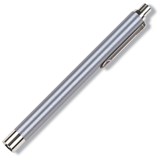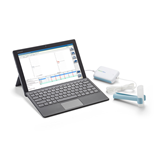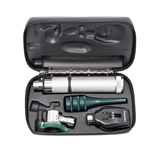"Our data suggest that this novel ion mobility-based method offers advantages over other procedures for lipoprotein particle analysis because it both measures particle size accurately on the basis of physical principles as well as directly counts the particles present at each size independently of particle composition.
"We believe this approach provides the only direct physical measurement of lipoprotein particle size and concentration for each lipoprotein subclass, from small HDL to large VLDL," said Richard E. Reitz, MD, co-lead investigator and acting vice president, Science and Innovation, and medical director, Quest Diagnostics Nichols Institute.
"We look forward to learning the results of additional research to identify the technique's clinical utility for risk assessment and treatment in patients with cardiovascular disease and related conditions."
Lipoprotein particles are fatty substances carried through the blood stream that affect cardiovascular health. High-density lipoproteins (HDL), referred to as "good" cholesterol, promote healthy cardiovascular function, but LDL and very-low density lipoproteins (VLDL), or "bad" cholesterol, may deposit on the walls of arteries, promoting atherosclerosis and other cardiovascular diseases.
Because particles of LDL, intermediate-density lipoprotein (IDL) and VLDL each contain one apolipoprotein B (ApoB) protein, ApoB concentration may give a better indication of large lipoprotein particle concentration than measurements of cholesterol concentrations alone(1).
The American Diabetes Association and American College of Cardiology Foundation recently published a consensus statement that recommends physicians use ApoB measurements to guide therapy in individuals with cardiometabolic risk who are on statin therapy(2). Yet, clinically available methods of measuring lipoprotein particle subpopulations are not standardised and generally use an algorithm to indirectly measure lipoprotein particle concentrations.
The objective of the study, conducted by Quest Diagnostics Nichols Institute, was to describe and validate the ability of the ion mobility technique to directly and accurately measure plasma lipoprotein particles, covering the spectrum of HDL, LDL, IDL and VLDL in healthy adults.
Approximately 260 healthy male and female adults who met the National Cholesterol Education Program's Adult Treatment Panel III guidelines for optimal plasma lipid and lipoprotein concentrations were recruited to establish reference distributions for the lipoprotein fractions detected by the method.
Concentrations of total HDL, HDL Large, total LDL, total IDL, total VLDL, and non-HDL particles were determined using the ion mobility technique and correlated with biochemical measurements of calculated triglycerides, HDL cholesterol, LDL cholesterol as well as plasma ApoA1 and ApoB.
Results showed that the ion mobility technique was very precise in measuring LDL particle size, producing a variation of less than one percent over approximately 48 preparations of the same sample.
The HDL and LDL concentrations varied less than 20 percent in these same preparations. The study also found a strong correlation (r=0.92) between the non-HDL (LDL, IDL and VLDL combined) concentration and the plasma concentration of ApoB, the single protein present in all non-HDL particles.
The strong correlation of ApoB with non-HDL particles using the ion mobility technique was expected, as both provide measurements of lipoprotein concentration. The comparatively poorer correlation with cholesterol reflects the varying concentrations of this compound within lipoprotein particles, underscoring the ion mobility technique's potentially unique advantage over other methods.
Specifically, while other techniques generally depend on cholesterol measurements to determine particle concentration, the ion mobility method measures lipoprotein particle concentration and size regardless of the particle's lipid, protein, triglyceride and cholesterol content.
Quest Diagnostics funded the study, which is titled "Direct Determination of Lipoprotein Particle Sizes and Concentrations by Ion Mobility Analysis." Results of the study are now available at: http://www.clinchem.org/cgi/content/abstract/clinchem.2007.100586.
Independent researchers expect this year to complete their review of an outcomes study designed to determine if the technique provides clinically useful information for predicting and monitoring cardiovascular disease in patients.
"While more research and development is required, we are excited by the findings of our analytical research, which clearly demonstrates that our ion mobility technique can measure particle size and concentrations using a direct, rather than algorithm-based method," said Michael P. Caulfield, PhD, scientific director, Research and Development, Endocrinology, Quest Diagnostics Nichols Institute, and one of the study's investigators.
"Depending on the results of the third-party outcomes study, we are optimistic that our ion mobility technique will provide the basis for developing a high-throughput standardised diagnostic test that will enable physicians to more accurately understand the unique lipoprotein characteristics of the individual patient."
The new technique uses the principles of ion mobility to provide direct measurement of particles. Ion mobility determines particle size based on the drift velocity of ion-charged particles as they pass through a layer of air under the force of an electric field.
Ion mobility, which is commonly used to analyse aerosols, is employed in nanotechnology, proteomics and drug development. In 2004, Quest Diagnostics co-exclusively licensed certain ion mobility patents for lipoprotein analysis from Ernest Orlando Lawrence Berkeley National Laboratory ("Berkeley Lab") in Berkeley, CA, and subsequently utilized the patent rights to develop its own test. Quest Diagnostics now has two patents pending for further technological advances.
In addition to Dr. Reitz, Ronald M. Krauss, MD, director of Atherosclerosis Research, the Children's Hospital Research Institute (CHORI), Oakland, CA, was a co-lead investigator on the study. Dr. Krauss co-developed the original patent while a senior scientist in the Life Sciences Division of Berkeley Lab.
Quest Diagnostics is a leader in cardiovascular disease diagnostics. In 1999, the company became the first diagnostic company to offer a high- sensitivity C-reactive protein (CRP) test cleared by the U.S. Food and Drug Administration for cardiac risk stratification. The Cardio CRP test helps physicians assess the risk a patient may have a heart attack based on CRP levels and other factors.
Quest Diagnostics was also one of the first diagnostic companies to provide lipid-panel test results that provide directly reported, rather than indirectly calculated, LDL levels for patients whose triglyceride levels are more than 400 mg/dl. Triglyceride levels above 400 mg/dl can cause LDL levels to reflect measurements at levels lower than they actually are, putting some patients at risk for under treatment.
- Suppliers
- New to MedicalSearch? Book a Demo
- Advertise with us
- Login
- Email Marketing
- Buyers
- Get Quotes
- Articles & Ideas
- Login
- Subscribe to newsletter
- My Details
- Get Quotes
- Accident & Emergency Care
- Aged Care & Disability
- Anaesthesia & Respiratory Care
- Beauty & Wellness
- Cardiology & Cardiac Surgery
- Commercial Cleaning & Laundry Supplies
- Dental Care & Oral Surgery
- Diagnostic Instruments & Medical Imaging
- Disinfection & Sterilisation
- ENT & Audiology
- Gynaecology & Obstetrics
- Homecare & Consumer Medical
- Hospital Equipment & Supplies
- Intensive Care Unit
- Laboratory & Pathology
- Medical Apparel
- Medical Devices & Products
- Medical Fridges & Freezers
- Medical Storage & Filing
- Medical Waste Management
- Optometry & Ophthalmology
- Orthopaedics & Podiatry
- Paediatrics & Neonatology
- Patient Monitoring & Management
- Physiotherapy & Rehabilitation
- PPE & Infection Control
- Single Use Medical Consumables
- Surgical Tools & Supplies
- Treatment Beds, Tables & Couches
- Veterinary Equipment
- Wheelchairs & Mobility Aids
- Get Quotes
- Accident & Emergency Care
- Aged Care & Disability
- Anaesthesia & Respiratory Care
- Beauty & Wellness
- Cardiology & Cardiac Surgery
- Commercial Cleaning & Laundry Supplies
- Dental Care & Oral Surgery
- Diagnostic Instruments & Medical Imaging
- Disinfection & Sterilisation
- ENT & Audiology
- Gynaecology & Obstetrics
- Homecare & Consumer Medical
- Hospital Equipment & Supplies
- Intensive Care Unit
- Laboratory & Pathology
- Medical Apparel
- Medical Devices & Products
- Medical Fridges & Freezers
- Medical Storage & Filing
- Medical Waste Management
- Optometry & Ophthalmology
- Orthopaedics & Podiatry
- Paediatrics & Neonatology
- Patient Monitoring & Management
- Physiotherapy & Rehabilitation
- PPE & Infection Control
- Single Use Medical Consumables
- Surgical Tools & Supplies
- Treatment Beds, Tables & Couches
- Veterinary Equipment
- Wheelchairs & Mobility Aids
Trusted by 520,000 Australian medical buyers
Buyers
- Discover products & solutions
- Login
- Subscribe To Newsletter
- Browse All Products
- Read Articles
Suppliers
Advertise
- Promote your products & solutions
- New to MedicalSearch? Book a Demo
- Login / Forgot Password
- Advertise Your Products
- Success Stories
- Email Marketing
- Suppliers
- Advertise with us
- Login
- Email Marketing
- Buyers
- Get Quotes
- Articles & Ideas
- Login
- Subscribe to newsletter
- My Details
Get Quotes
- Accident & Emergency Care
- Aged Care & Disability
- Anaesthesia & Respiratory Care
- Beauty & Wellness
- Cardiology & Cardiac Surgery
- Commercial Cleaning & Laundry Supplies
- Dental Care & Oral Surgery
- Diagnostic Instruments & Medical Imaging
- Disinfection & Sterilisation
- ENT & Audiology
- Gynaecology & Obstetrics
- Homecare & Consumer Medical
- Hospital Equipment & Supplies
- Intensive Care Unit
- Laboratory & Pathology
- Medical Apparel
- Medical Devices & Products
- Medical Fridges & Freezers
- Medical Storage & Filing
- Medical Waste Management
- Optometry & Ophthalmology
- Orthopaedics & Podiatry
- Paediatrics & Neonatology
- Patient Monitoring & Management
- Physiotherapy & Rehabilitation
- PPE & Infection Control
- Single Use Medical Consumables
- Surgical Tools & Supplies
- Treatment Beds, Tables & Couches
- Veterinary Equipment
- Wheelchairs & Mobility Aids
Get Quotes
- Accident & Emergency Care
- Aged Care & Disability
- Anaesthesia & Respiratory Care
- Beauty & Wellness
- Cardiology & Cardiac Surgery
- Commercial Cleaning & Laundry Supplies
- Dental Care & Oral Surgery
- Diagnostic Instruments & Medical Imaging
- Disinfection & Sterilisation
- ENT & Audiology
- Gynaecology & Obstetrics
- Homecare & Consumer Medical
- Hospital Equipment & Supplies
- Intensive Care Unit
- Laboratory & Pathology
- Medical Apparel
- Medical Devices & Products
- Medical Fridges & Freezers
- Medical Storage & Filing
- Medical Waste Management
- Optometry & Ophthalmology
- Orthopaedics & Podiatry
- Paediatrics & Neonatology
- Patient Monitoring & Management
- Physiotherapy & Rehabilitation
- PPE & Infection Control
- Single Use Medical Consumables
- Surgical Tools & Supplies
- Treatment Beds, Tables & Couches
- Veterinary Equipment
- Wheelchairs & Mobility Aids
Trusted by 520,000 Australian medical buyers







